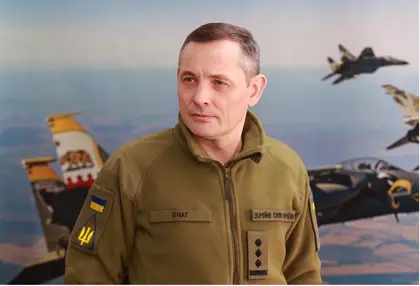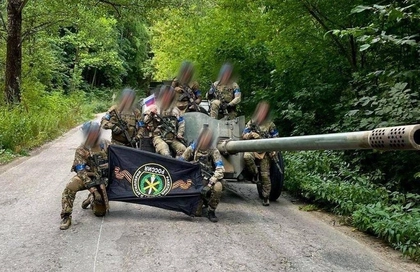The Ukrainian Air Force’s official spokesperson in a recent interview gave his insight into the role of air defenses in protecting citizens during the upcoming winter “heating season” and spoke about upgrades to its air power capabilities with new missiles and fighters.
In a wide-ranging interview with Ukrainian news outlet Novynarnia published on Monday, Colonel Yuriy Ihnat talked about the need to be truthful in his statements, particularly when there is a need to correct the many rumors that appear on social media concerning the highs and lows of the war. He said that this required a 24/7 effort as the barrage of information that could harm Ukraine’s defense is seemingly unending.
JOIN US ON TELEGRAM
Follow our coverage of the war on the @Kyivpost_official.
Ihnat is not just a spokesperson, he is a technical expert who has had to get to grips with the whole range of modern missiles, air defense systems, and (pretty soon) the aircraft supplied by Ukraine’s partners. In particular, this foreign assistance needs to be acknowledged so that “…when foreigners listen to stories about our pilots, tears come to their eyes. And this should benefit Ukraine,” the 30-year veteran explained.
The “missile-drone winter” ahead
Ihnat spoke in some detail about how Russia from the first days of the full-scale war tried to destroy all of Ukraine’s limited air defense assets and, though much was damaged they largely failed. He then spoke about last winter’s missile barrages against Ukraine’s infrastructure – Moscow’s attempt to freeze its citizens and destroy their morale. In some days as many as 75 missiles a day were launched against the country.

PICTURES: Kyiv in the Wake of Russia’s Devastating Missile Attack
In all during “the heating season” Russia fired over a thousand cruise and ballistic missiles and as many “kamikaze drones.” Yet, with the limited numbers of old Soviet long-range missile systems Ukraine then held, bolstered by some modern short-range systems such as Stinger, Starstreak and Polish Piorun missiles, its air defense forces managed to shoot down about 75 percent of what was fired.
Ukraine’s infrastructure was damaged, in some cases severely, but Inhat said the country survived and in the following months much was not only repaired but strengthened. Perhaps, perversely, Russia’s 2022 winter missile campaign gave Ukraine’s allies the incentive it needed to provide the longer-range defense capability it needed.
His assessment was that, while Russia has been stockpiling missiles for a repeat of last year it has nowhere near the same quantities available and though they will use them they will need to supplement them by using unmanned aerial vehicles (UAV-drones) such as the Shahed-type as well as first-person view (FPV) drones and loitering munitions such as the “Lancets” on the front line.
Increasing Ukraine’s air defense capability
Inhat said that in most Western military forces, air defense had not been given enough attention but again the war in Ukraine had belatedly focused attention on the subject. There has been an increase in the production capacity of air defense equipment particularly in the US, Germany and France.
Some of these are coming to Ukraine but the threat from Shaheds needs cheaper, short-range solutions such as Germany’s Gepard so that expensive anti-aircraft missiles aren’t wasted.
He went on to say there are not enough weapons in the world to completely protect the 603 thousand square kilometers of Ukraine or the 2.5 thousand kilometers of front line.
What are the best systems?
Novynarnia asked Inhat which of the western-supplied systems were the best NASAMS, IRIS-T, Patriot or SAMP/T? His reply was that each had their strengths and it depended on the characteristics of the incoming target which was the most appropriate system to use. He said that the medium-range IRIS-T and NASAMS were the workhorses of the air defense system against cruise missiles while “the Patriot is the one that knocks down ballistics!”
Patriot had not only downed 15 Kinzhal hypersonic missiles but also dozens of ballistic missiles and even Russian aircraft.
Inhat made reference to events on May 13 which he jokingly referred to as the “Bryansk Massacre” when Patriots downed five Russian aircraft over Bryansk Oblast in Russia: a Su-34 and a Su-35 aircraft, two Mi-8MTPR-1 air defense and one Mi-8 troop-carrying helicopters. He added that sometime later, another enemy Su-35 was shot down over the Black Sea.
He said that this was “thanks to non-standard decisive actions, Patriot air defense systems destroyed five aircraft in five minutes on the Bryansk axis, from where they were used to bombard our northern regions with guided aerial bombs.”
F-16 Fighter aircraft
Pressed about how many of the F-16 “Fighting Falcon / Viper” aircraft Ukraine will get, of what variant, and when, Inhat remained tight-lipped. He said that pilots and maintenance crews were well-advanced in their training and that Ukraine was looking at other types of Western aircraft.
He said that the process is not easy. It is not only pilots that need to be taught but support specialists too – those who maintain the equipment, those who program and load bombs and missiles. Ukraine has to learn to fight using this plane.
He said when they come, they, as with current aircraft, will be dispersed in locations around Ukraine. He thought that one thing was certain: “The presence in the strike group of F-16 aircraft, which will have a missile capable of destroying the enemy [at longer distances], will ‘add adrenaline’ to Russian pilots,” which are currently already reluctant to enter Ukrainian airspace.
He added that it was a pity that we won’t have them in time for this winter’s heating season.
Do you sleep at night?
“When there is a massive enemy attack, I monitor the situation together with our group on duty, take phone calls even in the middle of the night.
“When the situation is more or less calm, it is important to sleep, because strength and energy will be needed for the working day when I will be attacked - by dozens of our and foreign media.
“I once had 38 live streams in a day,” then smiling he said “...There’s nothing wrong with that, you just burn out when you say the same thing 100 times.”
He talked about the need to address different things to the media: “…representatives of different countries want to hear something related to them – how exactly their weapons helped to protect Ukrainians. Understanding this comes with experience... for the Germans, we should talk about IRIS-T and Gepard... Italians or Americans get different rhetoric. Thus, with small steps, we achieve the result.”
A full translation of the extremely comprehensive interview is available here.
You can also highlight the text and press Ctrl + Enter






